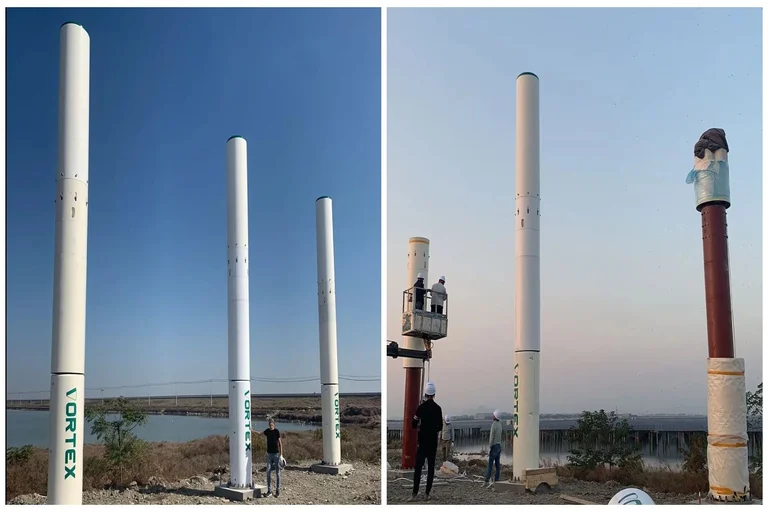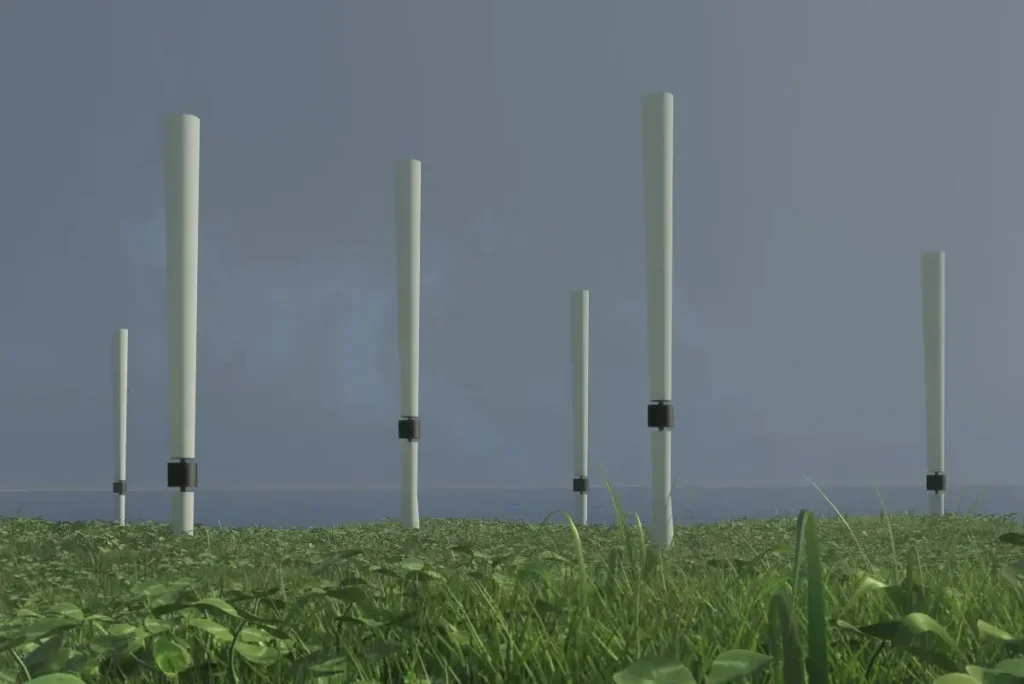
Bladeless Wind Turbine Clean Energy Solution Without Harming Birds
The Bladeless Wind Turbine is a groundbreaking innovation in renewable energy. Unlike traditional turbines, it generates clean power without harming birds. This modern design produces clean electricity while keeping birds safe & protecting the environment. With the growing need for sustainable power, bladeless technology is becoming a smarter, greener choice for the future.
How Bladeless Wind Turbines Work?
Bladeless wind turbines operate on a simple yet innovative principle known as vortex shedding. Instead of using large spinning blades, these turbines capture the vibrations created when wind flows around a vertical cylinder. The movement of the cylinder is then converted into electricity through an alternator. This design makes the turbine quieter, safer for birds, and easier to install in urban or remote areas. Unlike traditional turbines, they don’t need heavy gearboxes or complex parts, which reduces both maintenance costs and environmental impact.
The Role of Vortex Shedding Technology:
Bladeless wind turbines utilize a principle known as vortex shedding technology, also referred to as vortex-induced vibration. When wind flows past a cylindrical mast, it generates alternating low-pressure vortices beyond the structure. If the mast has a natural resonant frequency close to the frequency of these vortices, it begins to oscillate. A power conversion mechanism—usually using electromagnetic induction with coils and magnets—harnesses these oscillations and converts mechanical vibrations into electrical energy without blades or gearboxes.
Benefits of Bladeless Wind Turbines:
Bladeless wind turbines offer many benefits that make them a compelling alternative to traditional wind turbine designs.
1. Protect Birds and Wildlife:
Bladeless wind turbines generate energy through vibrations instead of spinning blades, so they don’t harm birds or bats. This design actively protects wildlife and supports biodiversity.
2. Operate Quietly in Any Environment:
These turbines operate quietly because they don’t have any noisy blades. Because they don’t disturb people, they are ideal for use in residential areas, cities, and other noise-sensitive areas.
3. Low Maintenance Required:
Bladeless turbines endure less mechanical wear and tear because they lack complicated gearboxes and heavy rotating components. Over time, this reduces the need for maintenance and saves money.
4. Install Easily in Urban and Remote Areas:
Their lightweight structure also allows for easier installation. The compact and lightweight design allows easy installation on rooftops or isolated locations. Their simple setup helps bring renewable energy to places where traditional turbines can’t fit.
5. Reducing Noise Pollution:
One of the biggest advantages of bladeless wind turbines is that they create very little noise due to their design, making them ideal for residential and urban areas where noise pollution is a concern. They operate quietly, unlike traditional turbines with loud spinning blades.
Why Bladeless Wind Turbines Are Safer for Birds and Wildlife?

Bladeless wind turbines protect birds and wildlife more effectively than traditional wind turbines. Traditional turbines spin large blades that pose a serious risk to birds and bats, often causing deadly collisions. In contrast, bladeless turbines generate energy through vibrations, eliminating the need for rotating blades. This design makes them a safer choice, allowing wildlife to move freely around them without risk. As a result, bladeless turbines not only produce clean energy but also safeguard the environment by reducing harm to animals.
Cost and Accessibility of Vortex Turbine:
Vortex Bladeless offers three main models, each catering to different energy needs:
1. Vortex Nano:
About 1 meter tall, producing around 3 watts of power. It is designed for very small-scale, off-grid applications such as sensors, remote monitoring devices, or low-energy equipment. Early estimates suggest a price of around $250, which makes it relatively affordable compared to other wind-powered technologies.
2. Vortex Tacoma:
This model stands at 2.75 meters and produces about 100 watts of output. It is considered more suitable for homes, small farms, or businesses that want to supplement their solar systems. Media reports and prototype discussions have placed its cost around $5,000, although this may vary depending on location and manufacturing scale.
3. Atlantis/Grand Vortex:
The design ranges from 9 to 13 meters in height and is expected to produce 1 kilowatt of output. This larger model targets rural areas, small industries, or community-scale power needs. Although exact pricing is not available yet, its larger size and higher output will likely make it significantly more expensive than the Tacoma model.
Cost Efficiency & Longevity:
- 53% cheaper to manufacture than traditional turbines.
- 45% lower cost per kWh in low-to-medium wind conditions.
- Lifespan of 32-96 years, far exceeding conventional turbines.
Installation and Scalability Bladeless Wind Turbines:
Bladeless wind turbines are much easier to install than large, bladed turbines. They don’t require heavy foundations, big cranes, or complex gearboxes, so you can set them up faster with less concrete and steel. Their smaller installation footprint makes them a realistic option for backyards, rooftops, small farms, and sites where heavy equipment can’t reach.
Because each unit is relatively light and modular, you can scale by adding more units instead of replacing one small unit with a giant one. A home might start with one Tacoma-class unit and add a second or third over time as the budget and needs grow. This modular approach reduces upfront cost pressure and allows communities to build capacity step by step.
One practical point: performance still depends on siting. Although you can install the units more easily, you must place them where wind flows steadily—on rooftops with clear exposure or in an open fields. Therefore, conducting a short wind assessment is worth the small extra cost.
Potential for Urban and Remote Areas:
Bladeless turbines have two major benefits in urban areas: they are silent and have a minimal visual impact. Because of this, they are more likely to be accepted in communities where big blade turbines are prohibited or unpopular. To provide more reliable local power, small units can be combined with rooftop solar; during sunny hours, solar power can be used, and during cloudy or windy conditions, oscillating wind can be used.
For remote places—mountain villages, island communities, or emergency camps — their lightweight and simple installation offers big advantages. You can transport the units without heavy machinery and set them up quickly, providing off-grid power for lights, phone charging, or small pumps. This is especially helpful where bringing fuel or shipping bulky solar panels is difficult.
Keep in mind that the output per unit is modest today. This means bladeless technology often works best as a complement to other solutions (solar, batteries, diesel backup), rather than as a full replacement—at least until larger models and mass production improve watts-per-dollar.
Challenges and Limitations of Bladeless Wind Turbines:
Bladeless turbines face clear technical and market hurdles. First, they have lower power density than large rotary turbines — they produce useful but modest electricity per unit. This limitation keeps them in small-scale or supplemental roles today, rather than replacing large wind farms.
Second, certification and standards can slow adoption. Most wind standards were written for rotating turbines, so bladeless designs need adapted testing, new certification steps, and long field trials before buyers and utilities fully trust them. This adds time and cost before mass sales can begin.
Third, production scale and cost remain uncertain. The company has run prototypes and pilots, but it is still working out full industrial manufacturing and global logistics. Until production scales, manufacturers will keep the unit prices high, and in many markets, import duties and shipping will increase the cost.
Role of Bladeless Wind Turbines in Sustainable Energy Goals:
Bladeless technology helps meet practical sustainability goals in two ways. First, it expands access to clean electricity in off-grid and underserved areas, directly contributing to energy access targets. Second, by increasing the use of distributed renewables reduces reliance on diesel and other fossil fuels, supporting emissions reduction targets. For these reasons, governments and NGOs focused on electrification and decarbonization naturally partner with pilot projects and subsidy programs.
As the world seeks sustainable alternatives to fossil fuels, bladeless wind energy can play a key role. With better investment, innovation, and public awareness, these turbines could become a common part of cities and villages, helping us move closer to a cleaner and greener energy future.
FAQs
Q1. What is a bladeless wind turbine?
Ans. A bladeless wind turbine is a new type of wind energy technology that generates electricity without rotating blades. Instead, it harnesses vibrations caused by the wind to create power. This design makes it safer for birds, quieter, and easier to install in smaller areas like rooftops or farms.
Q2. How much does a bladeless wind turbine cost?
Ans. Bladeless wind turbine costs vary greatly by type and power output. They range from around $5,000 to $20,000 for high-output commercial units and $600 for smaller, 500W home models, with prices as low as $0.50 per watt for large systems. Cheaper, entry-level units are available but provide very limited power, while premium options can cost significantly more.
Q3. Are bladeless wind turbines good for cities?
Ans. Yes, bladeless turbines are well-suited for cities because they are compact, lightweight, and quiet. Unlike traditional turbines, they don’t require huge open spaces, making them practical for rooftops, small plots, and urban areas where clean energy demand is high but land is limited.
4. What are the main benefits of bladeless wind turbines?
Ans. Bladeless turbines offer eco-friendly solutions, are safe for birds, and require less maintenance. They cost less to install than traditional turbines and scale up easily by adding more units. Their ability to fit in urban areas also makes them a great choice for hybrid energy systems with solar panels.
Read More Article>https://www.climatechallange.com/top-7-tips-how-to-take-care-of-birds-in-summer/